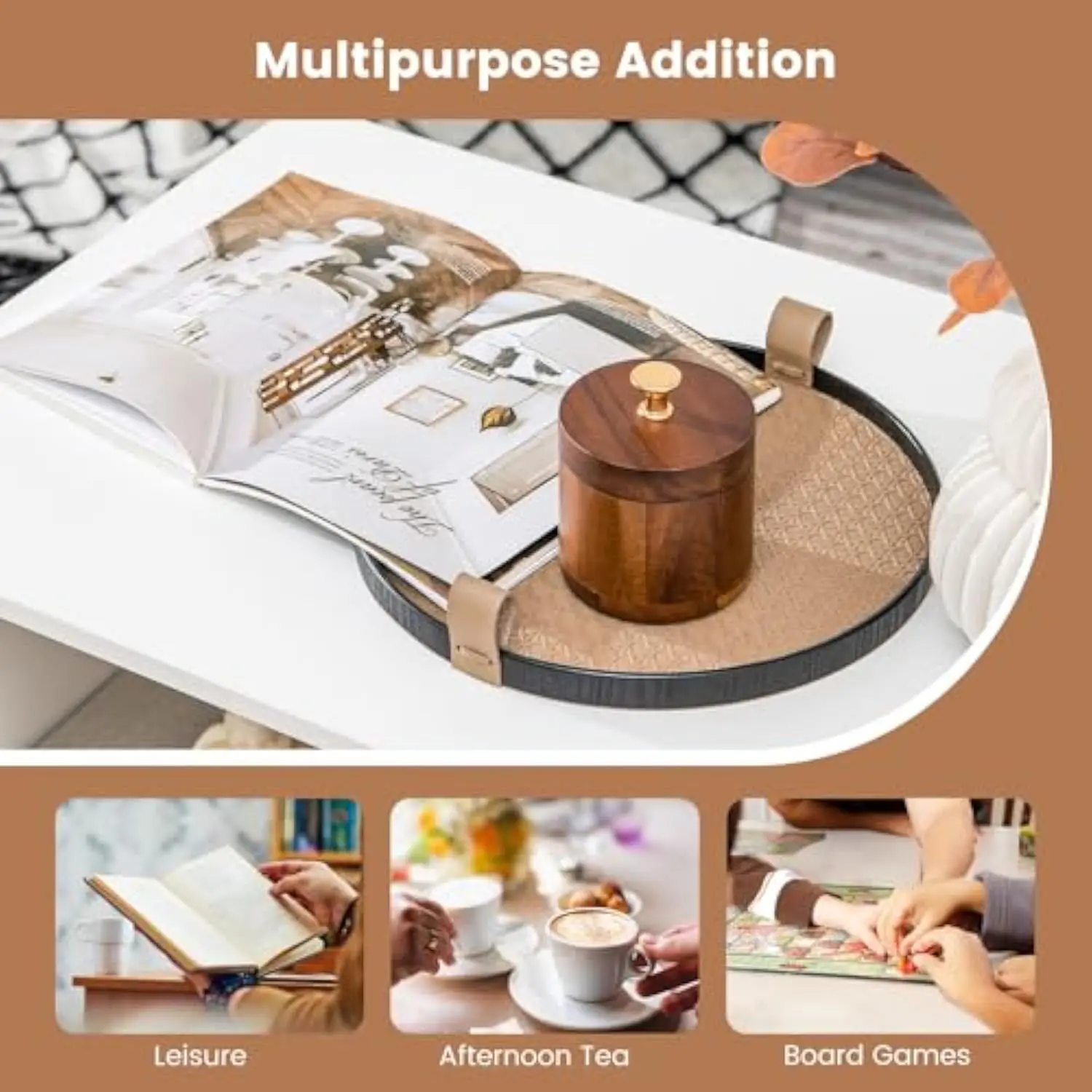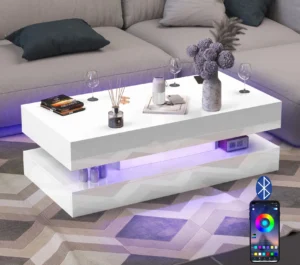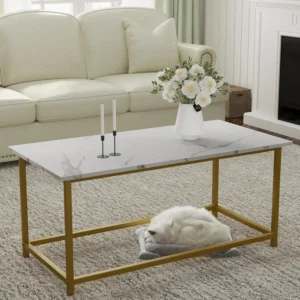Introduction
Selecting the perfect coffee table for a large sectional sofa can feel like solving a design puzzle. The expansive footprint of a sectional creates unique challenges that standard coffee table guidelines simply don’t address. When done right, the coffee table becomes an anchor for your living space, creating balance and enhancing both the aesthetic appeal and functionality of your sectional seating arrangement.
Many homeowners struggle with common dilemmas: coffee tables that look comically small beside their generous sectionals, pieces that disrupt natural traffic flow, or tables that make reaching for a drink awkward from certain seats. The perfect coffee table needs to strike a delicate balance between size, shape, function, and style.
Throughout this guide, we’ll explore everything you need to know about pairing coffee tables with large sectionals—from sizing principles and shape considerations to material selection and styling tips. Whether you’ve just invested in a spacious sectional or are looking to upgrade your existing setup, these insights will help you create a cohesive, functional living space centered around your large mid-century coffee tables and comfortable seating.
Understanding the Unique Dynamics of Large Sectionals
Large sectionals transform living spaces but create distinct design challenges that affect coffee table selection. Understanding these dynamics is essential before making any decisions.
The Scale Factor
Standard coffee table rules break down when applied to sectionals. While a conventional sofa might be 6-8 feet (1.8-2.4 m) long, sectionals can extend 10-14 feet (3-4.3 m) or more, creating a dramatically different scale relationship. What looks proportionate with a regular sofa often appears undersized and insignificant alongside a substantial sectional.
Accessibility Challenges
With multiple seating positions arranged at various angles, sectionals create accessibility issues that standard sofas don’t present. Everyone seated should ideally be able to reach the coffee table without standing up—a requirement that often means rethinking traditional coffee table placement or considering multiple tables.
Visual Balance
Large sectionals dominate visual space, making balance crucial. Your coffee table needs sufficient visual weight to anchor the seating area without competing with the sectional. This delicate equilibrium depends on thoughtful consideration of shape, material, and proportion.
Configuration Considerations
Different sectional arrangements demand different approaches. An L-shaped sectional creates an obvious space for a coffee table, while a U-shaped design might require a larger central table or multiple smaller pieces. Understanding whether to choose a round or square coffee table for your sectional arrangement significantly impacts both function and flow in your space.
Core Principles: Sizing and Proportion for Large Sectionals
Getting the size right is perhaps the most crucial factor when selecting a coffee table for your large sectional. These fundamental principles will guide you toward properly proportioned options:
The Golden Two-Thirds Rule
For optimal visual balance, your coffee table length should be approximately two-thirds the length of your sectional’s main segment. For example:
– For a 9-foot (2.7 m) main sectional segment, look for a coffee table approximately 6 feet (1.8 m) long
– For a 10-foot (3 m) sectional segment, a coffee table between 6.5-7 feet (2-2.1 m) works well
This proportion ensures the coffee table has enough presence without overwhelming the space.
Height Alignment
The ideal coffee table height sits 1-2 inches (2.5-5 cm) lower than your sectional’s seat height. This relationship:
– Creates visual harmony
– Ensures comfortable reaching distance
– Allows for easy visual connection across the seating area
Most sectional seats measure 17-19 inches (43-48 cm) high, making coffee tables around 16-18 inches (40-45 cm) tall generally ideal.
Clearance Guidelines
Allow 14-18 inches (35-45 cm) between your sectional and coffee table. This measurement:
– Provides comfortable leg room when seated
– Allows easy passage for people moving around the furniture
– Creates a functional relationship between pieces without feeling cramped
Too little clearance makes the space feel crowded, while too much creates disconnection between the pieces.
Depth Considerations
Coffee table depth becomes particularly important with sectionals that have deeper seats or recliners. Generally, the table depth should allow comfortable reach from all seats, typically between 28-36 inches (71-91 cm) for larger sectional arrangements.
The design advantages of large mid-century coffee tables become particularly evident when properly sized for sectionals, creating both functional surfaces and visual anchors for expansive seating areas. Browsing through mid-century modern large coffee tables can provide inspiration for well-proportioned options that complement generous sectional dimensions.
Functionality First: What Do You Need Your Coffee Table To Do?
Before getting caught up in aesthetics, consider what functions your coffee table needs to serve. Large sectionals often become central gathering places in homes, meaning the coffee table must meet various practical demands.
Beyond Basic Surface Needs
Consider how you actually use your living space:
– Do you frequently entertain, requiring space for multiple drinks and snacks?
– Is this a primary spot for family meals or casual dining?
– Do you need space to display decorative items or books?
– Will you use the surface for working, crafting, or gaming?
Your honest assessment of these needs should guide size, material, and design choices.
Storage Solutions
Large sectional setups often benefit from integrated storage options:
– Drawers for stashing remote controls, gaming controllers, or small items
– Shelves for books, magazines, or display items
– Lift-tops that create adjustable height work surfaces
– Ottoman storage for blankets, pillows, or toys
These functional elements are particularly valuable in family rooms where maintaining organization can be challenging.
Entertainment Considerations
If your sectional serves as the primary entertainment area, prioritize:
– Stable surfaces that won’t easily tip over if bumped
– Materials that can withstand drink condensation without damage
– Sufficient surface area for games, food, and electronics
– Easy-to-clean finishes that don’t require constant maintenance
Family-Friendly Features
Households with children or pets should consider safety and durability:
– Rounded corners to prevent injuries from sharp edges
– Sturdy construction that can withstand climbing or leaning
– Durable materials resistant to scratches and spills
– Non-glass options for homes with very young children
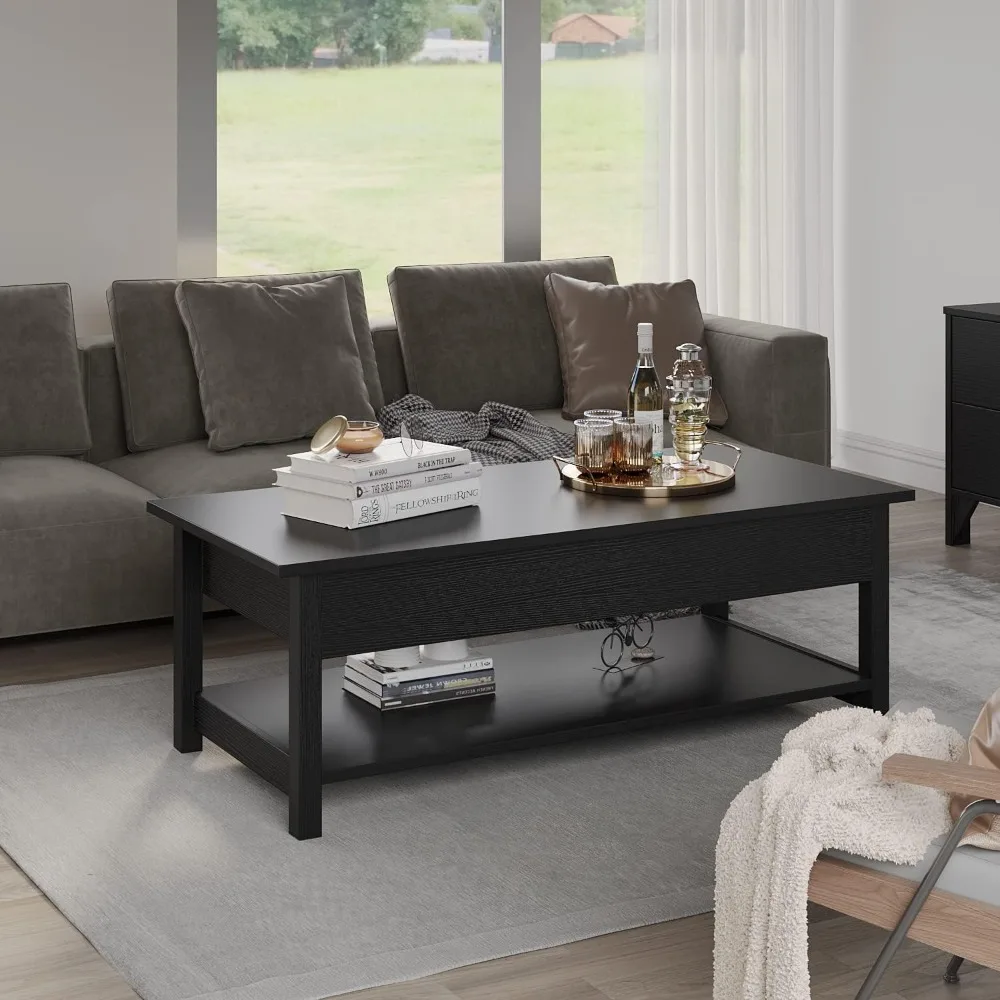
For multifunctional solutions that maximize utility, mid-century modern lift-top coffee tables offer both elegant design and practical features ideal for sectional seating arrangements.
Coffee Table Shapes Decoded for Large Sectionals
The shape of your coffee table significantly impacts both the functionality and visual effect of your sectional arrangement. Each shape creates different opportunities and challenges:
Rectangular Tables
Best for: L-shaped sectionals, parallel sectionals facing media centers
Advantages:
– Mirrors the linear lines of most sectional designs
– Provides maximum usable surface area
– Allows everyone seated to have relatively equal access
– Creates a structured, organized appearance
Considerations:
– Ensure corners don’t create traffic hazards in walking paths
– Look for lengths around 2/3 of your main sectional segment
– Width should allow comfortable clearance around all sides
Mid-century modern rectangular coffee tables offer clean lines that complement the geometric forms of most sectional arrangements while providing ample surface area.
Square Tables
Best for: U-shaped sectionals, balanced sectional arrangements with equal sides
Advantages:
– Creates a central focal point equidistant from all seats
– Offers balanced visual weight
– Works well in square room layouts
– Can often provide more substantial surface area
Considerations:
– Requires sufficient central space (minimum 3-4 feet/0.9-1.2 m square)
– May create awkward reaches from corner sections
– Creates more formal, structured feeling
Round/Oval Tables
Best for: Sectionals with chaises, arrangements with tight spaces
Advantages:
– Softens the angular lines of sectionals
– Eliminates sharp corners for safety
– Improves traffic flow around the furniture
– Creates a more casual, inviting atmosphere
Considerations:
– Provides less usable surface area than rectangular tables
– Can look undersized unless diameter is substantial
– Works best when the diameter is at least 36-48 inches (91-122 cm)
Organic/Freeform Shapes
Best for: Contemporary spaces, artistic interiors
Advantages:
– Creates visual interest and unique focal points
– Can be designed to fit unusual sectional configurations
– Makes a strong design statement
– Often allows creative nesting or arrangement
Considerations:
– Can be more challenging to find ready-made options
– May require custom design for optimal fit
– Functionality sometimes sacrificed for form
Nesting Tables/Clusters
Best for: Versatile spaces, rooms where furniture arrangement changes frequently
Advantages:
– Provides flexible surface options that can be reconfigured
– Allows tables to be moved to serve different seats as needed
– Creates visual interest through layering
– Can be separated for serving or additional surfaces
Considerations:
– Individual tables may be too small for larger items
– Creates a busier visual effect than a single table
– Requires more maintenance to keep organized
Mastering statement piece large coffee tables allows you to create dramatic focal points that anchor expansive sectional arrangements while expressing your personal style.
Material Matters: Choosing a Finish That Fits Your Style & Life
The material of your coffee table significantly impacts not just aesthetics but durability and maintenance requirements—crucial considerations for heavily used sectional seating areas.
Wood Options
Solid Wood
– Offers warmth, natural beauty, and durability
– Varies dramatically in weight and hardness between species
– Can be refinished if damaged
– Susceptible to water rings and scratches without proper care
Veneer
– Provides wood look at lighter weight and lower cost
– More stable with less warping than some solid woods
– Varies widely in quality and durability
– Cannot typically be refinished if damaged
Reclaimed Wood
– Brings character, history, and sustainability
– Each piece offers unique variations and patina
– Generally very sturdy and durable
– May have irregularities in surface and texture
Metal Varieties
Steel/Iron
– Provides industrial strength and visual weight
– Works well for bases with other material tops
– Extremely durable but can scratch flooring without protection
– Available in various finishes from matte black to polished chrome
Brass/Gold Tones
– Adds warmth and luxurious feel
– Creates sophisticated, elegant impression
– Requires regular cleaning to maintain luster
– Complements rich fabric sectionals beautifully
Glass Surfaces
Clear Glass
– Creates visual lightness in spaces dominated by large sectionals
– Makes small spaces feel more open
– Shows every fingerprint and dust particle
– Requires frequent cleaning for optimal appearance
Frosted/Smoked Glass
– Hides fingerprints and dust better than clear glass
– Adds sophisticated, contemporary feel
– Still provides visual lightness but with more substance
– Creates interesting light effects in the room
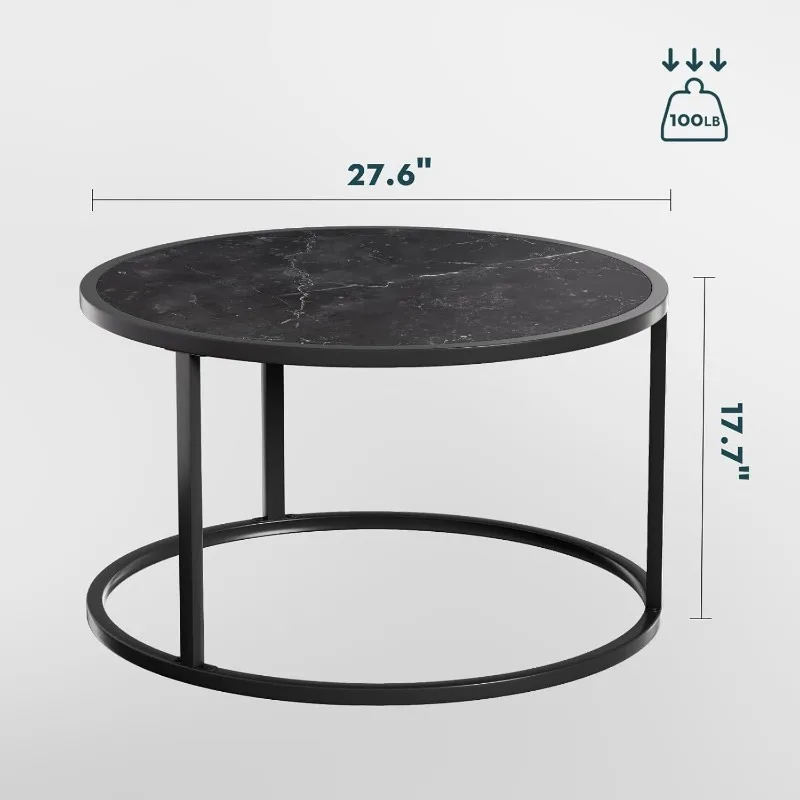
Stone Options
Mid-century modern marble top coffee tables provide timeless luxury that contrasts beautifully with upholstered sectionals. Other stone options include:
Granite/Marble
– Creates substantial visual weight
– Extremely durable but potentially porous
– Each piece offers unique patterns and coloration
– Generally requires more substantial base support
Travertine/Limestone
– Provides natural, earthy texture
– Lighter in weight than marble or granite
– More susceptible to staining without proper sealing
– Creates organic, warm feeling
Upholstered Surfaces
Fabric/Leather Ottoman Tables
– Offers dual functionality as seating and surface (with tray)
– Creates softness in contrast to angular sectionals
– Provides safe option for homes with small children
– Less practical for food service or liquid-containing items
Mixed Material Combinations
The most interesting coffee tables often combine materials:
– Wood tops with metal bases
– Glass surfaces on wood frames
– Stone insets in wooden structures
– Upholstered sections with hard surface areas
Choose combinations that echo other elements in your room for cohesion.
Tailoring to Your Sectional’s Configuration
Different sectional configurations create distinct spaces that require specific coffee table approaches:
L-Shaped Sectionals
L-shaped sectionals create a natural, partially enclosed area for your coffee table. For this configuration:
Single Large Table Approach:
– Rectangle or square table that fills approximately 2/3 of the space
– Position closer to the sectional junction for balanced access
– Ensure 14-18 inches (35-45 cm) clearance on all accessible sides
Multiple Table Approach:
– One medium table positioned at the junction
– Smaller side table or nesting tables near the extended end
– Creates more flexible arrangement for various activities
U-Shaped Sectionals
U-shaped sectionals create a fully enclosed “conversation pit” that demands thoughtful coffee table selection:
Centering Strategies:
– Large square or round table centered in the U
– Table diameter/width should allow approximately 18 inches (45 cm) clearance from all sections
– Consider substantial materials that can visually hold the space
Accessibility Solutions:
– Tables with shelving underneath accessible from multiple sides
– Round tables that eliminate corner obstructions
– Multiple small tables that can be rearranged as needed
Chaise-End Sectionals
Asymmetrical sectionals with chaise extensions create unique challenges:
Balancing the Asymmetry:
– Rectangular tables positioned parallel to the main sectional body
– Round tables placed slightly off-center toward the main seating section
– L-shaped or curved tables that echo the sectional’s form
Expert arrange room large coffee table techniques can help you determine the ideal placement for any sectional configuration, ensuring both aesthetic harmony and functional access.
Styling Your Coffee Table Like a Pro
Once you’ve selected the perfect coffee table, styling it appropriately completes the look while maintaining functionality:
Balancing Visual Weight
Large sectionals create substantial visual volume that your coffee table styling should balance:
– Use taller elements (like substantial vases or sculptures) to draw the eye upward
– Create groupings rather than scattered individual items
– Consider the “rule of thirds” for height variations
– Don’t overcrowd—leave at least 50% of the surface clear for use
Creating Cohesion
Your coffee table should connect visually to other elements in the room:
– Echo materials or colors from the sectional or other furniture
– Include elements that reference accent pillows or artwork
– Consider how mid-century modern coffee end table sets can create cohesive groupings throughout the room
Scale-Appropriate Accessories
Large coffee tables require properly sized accessories:
– Books or trays should be substantial enough to make an impact
– Group smaller items together on trays to create visual unity
– Consider the view from all sides of the sectional
– Layer items at different heights and depths for interest
Practical Styling
Maintain functionality while achieving aesthetic goals:
– Create distinct zones for decor and functional use
– Use trays to contain smaller items and make them easily movable
– Consider how styling will work when the table is actually being used
– Rotate seasonal elements to keep the look fresh
Mid-Century Modern Coffee & End Table Sets, Mid-Century Modern Coffee Table Sets, Mid-Century Modern Oval Coffee Tables
Price range: $257.48 through $331.04 Select options This product has multiple variants. The options may be chosen on the product pageMid-Century Modern Glass Top Coffee Tables, Mid-Century Modern Glass Top Side & End Tables
$460.58 Select options This product has multiple variants. The options may be chosen on the product pageMid-Century Modern Glass Top Coffee Tables, Mid-Century Modern Vintage Coffee Tables, Mid-Century Modern Vintage Side & End Tables
$725.36 Select options This product has multiple variants. The options may be chosen on the product pageMid-Century Modern Lift Top Coffee Tables, Mid-Century Modern Square Coffee Tables
$454.73 Select options This product has multiple variants. The options may be chosen on the product pageMid-Century Modern Large Coffee Tables, Mid-Century Modern Rectangular Coffee Tables
$603.26 Select options This product has multiple variants. The options may be chosen on the product pageMid-Century Modern Marble Top Coffee Tables, Mid-Century Modern Rectangular Coffee Tables, Mid-Century Modern White Coffee Tables
Price range: $163.28 through $189.22 Select options This product has multiple variants. The options may be chosen on the product page
Advanced Strategies for Large Spaces
Particularly generous rooms with large sectionals may require additional strategies to create cohesive, well-designed spaces:
Using Multiple Coffee Tables Effectively
For extremely large sectional arrangements:
– Consider two identical rectangular tables placed side by side with a small gap
– Use a central larger table with coordinating side tables at the ends
– Create asymmetrical arrangements with tables of varying heights
– Ensure sufficient walking paths between grouped tables
Layering with Area Rugs
Define your seating zone and add warmth:
– Choose a rug large enough to accommodate both the sectional and coffee table
– Ensure at least the front legs of the sectional rest on the rug
– Select patterns that complement rather than compete with your coffee table
– Consider texture contrasts (plush rug with sleek table surface)
Integrating Appropriate Lighting
Highlight your coffee table area to create a focal point:
– Position floor lamps at sectional corners to cast light across the table
– Consider how pendant lighting above centers attention on the table
– Add table lamps on side tables to create balanced lighting
– Ensure lighting is practical for activities you regularly enjoy
Custom Solutions for Unique Spaces
Some sectional arrangements benefit from made-to-order solutions:
– Custom-cut glass or stone tops sized perfectly for your space
– Modular coffee table systems that can be reconfigured
– Convertible options that adjust in height or expand in surface area
– Built-in elements that create permanent solutions for unusual spaces
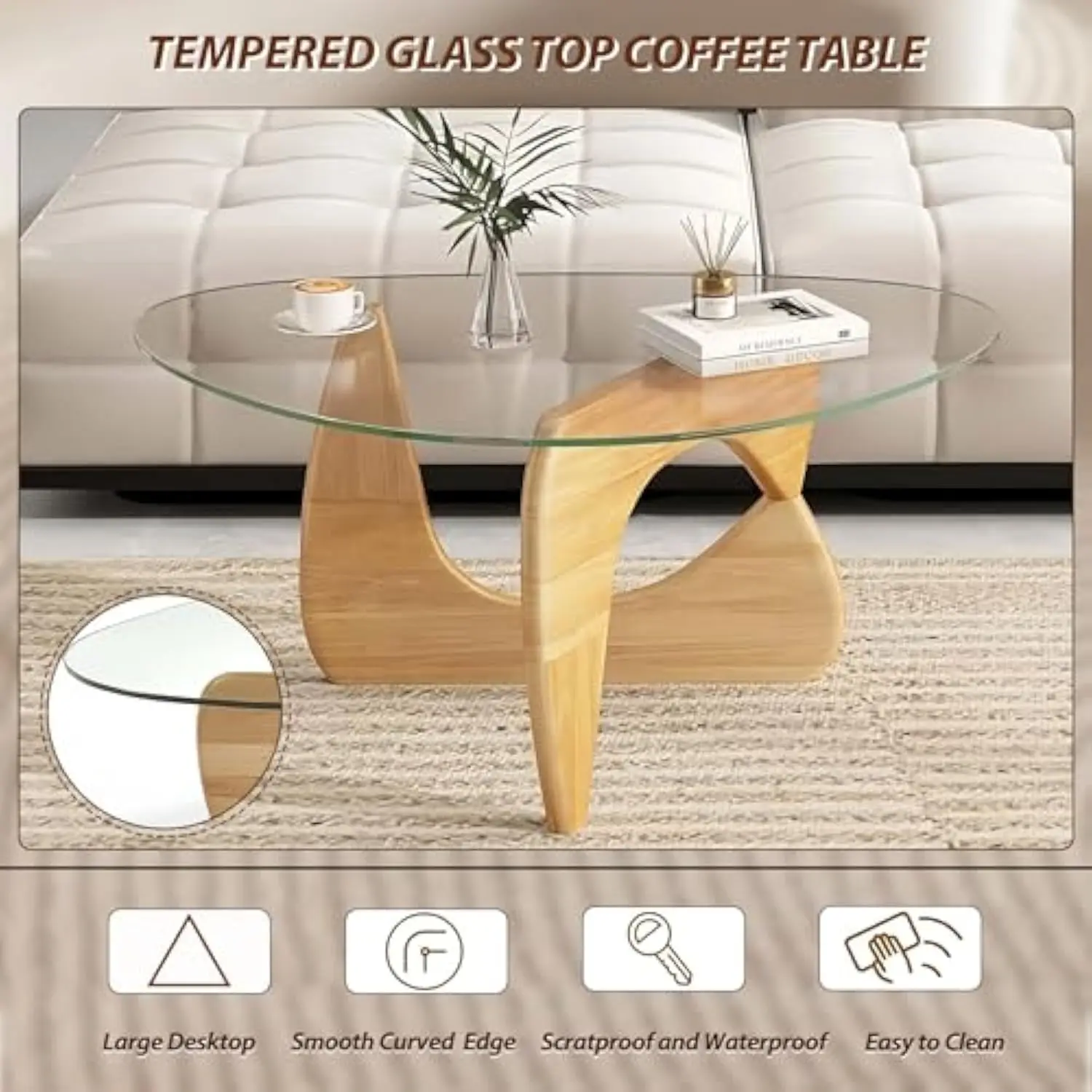
Mid-century modern glass top coffee tables can create an airy, open feeling around substantial sectionals, preventing the furniture arrangement from feeling too heavy or crowded.
Common Pitfalls to Avoid When Choosing Your Coffee Table
Even with careful planning, certain mistakes commonly occur when pairing coffee tables with large sectionals:
Size Mismatches
• Too Small: Tables under 36 inches (91 cm) long typically disappear visually beside large sectionals, creating awkward proportions and limited functionality.
• Too Large: Tables with less than 14 inches (35 cm) clearance make navigation difficult and create a cramped feeling.
Height Incompatibilities
• Too Tall: Tables higher than your sectional seat create awkward reaching angles and visual discord.
• Too Low: Tables more than 4 inches (10 cm) below your seat height cause uncomfortable bending and make the pieces feel disconnected.
Traffic Flow Obstructions
• Placing tables that block natural pathways through the room, forcing awkward detours around the furniture arrangement.
• Positioning corners or edges in line with high-traffic walking paths, creating potential hazards.
Material Misalignment
• Selecting delicate materials in high-use family spaces where durability should be prioritized.
• Choosing heavy materials like marble without considering floor support or mobility needs.
Style Disconnects
• Pairing ultra-modern glass and chrome tables with traditional, rolled-arm sectionals.
• Selecting rustic, distressed wood tables for sleek, contemporary sectional arrangements.
Function Oversight
• Prioritizing an artistic statement piece that lacks practical surface space for daily use.
• Choosing tables without considering storage needs in smaller living spaces.
Maximize small spaces nesting coffee tables can provide flexible solutions that adapt to changing needs while avoiding many common pitfalls of fixed-size coffee tables.
Frequently Asked Questions
What’s the optimal distance between a coffee table and sectional?
For comfortable use while maintaining a connected feel, keep 14-18 inches (35-45 cm) between your sectional and coffee table. This allows enough room for legs while keeping drinks and items within easy reach.
When should I use multiple coffee tables instead of one large table?
Consider multiple tables when: your sectional exceeds 12 feet (3.7 m) in length, your space has an irregular shape, you frequently rearrange your furniture, or you host gatherings with varied activity zones.
Which coffee table shape works best with an L-shaped sectional?
Rectangular tables generally work best with L-shaped sectionals, positioned parallel to the longer section. The rectangle echoes the sectional’s lines while providing maximum usable surface area for all seated positions.
Should my coffee table match my sectional color?
Rather than matching exactly, choose complementary tones. Create intentional contrast—light tables with darker sectionals or vice versa—while incorporating elements that tie to your overall color scheme through accessories or secondary materials.
What are some budget-friendly options that still look proportionate?
Large tables don’t need to be expensive. Consider: oversized ottoman coffee tables with trays, paired smaller tables positioned together, DIY options using large salvaged materials, or hollow-core designs that look substantial but weigh and cost less.

